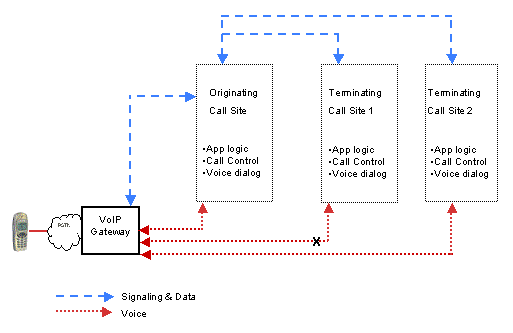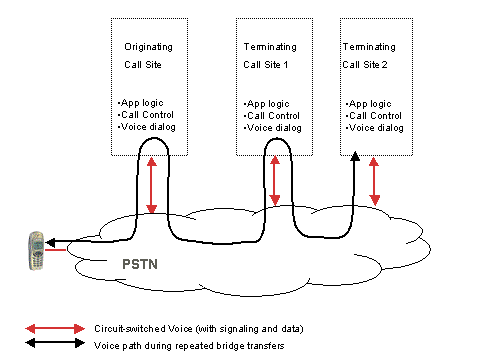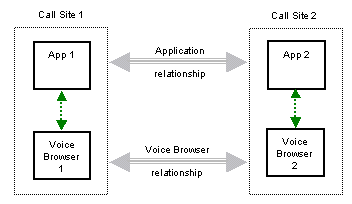A voice browser provides the means for people to use their voice
to interact with appropriately designed applications. Users
generally connect to voice browsers by dialling an access number.
The voice browser in turn retrieves markup (e.g. VoiceXML) and other
resources from an application server. In some situations it is
appropriate to transfer the user from one voice browser to another.
In other situations, the user may start from a visual web page and
then transfer to a voice browser, yet another possibility is
transfer from a voice browser to a human operator.
This document describes the requirements for how voice browsers
and other call sites can cooperate by sharing data to create a
seamless caller experience. An example of a potential resulting
benefit to a caller is not having to re-enter the same information
repeatedly at different call sites. A potential benefit for service
providers is a flexible architecture for deploying and
interconnecting disparate call sites.
Status of this Document
This section describes the status of this document at the
time of its publication. Other documents may supersede this
document. The latest status of this document series is maintained
at the W3C.
This is a working draft of the Voice Browser Interoperation
Requirements. You are encouraged to subscribe to the public
discussion list <www-voice@w3.org>
and to mail in your comments as soon as possible. To subscribe,
send an email to <mailto:www-voice-request@w3.org>
with the word subscribe in the subject line (include the
word unsubscribe if you want to unsubscribe). A public
archive is available online.
This specification describes requirements for voice browser
interoperation, and forms part of the proposals for the W3C Speech
Interface Framework. This document has been produced as part of the
W3C Voice Browser Activity,
following the procedures set out for the W3C Process. The
authors of this document are members of the Voice Browser Working
Group (W3C Members only).
A current list of patent disclosures for the Voice Browser
activity may be found on the Working Group's patent disclosure page.
Publication as a Working Draft does not imply endorsement by the
W3C Membership. This is a draft document and may be updated,
replaced or obsoleted by other documents at any time. It is
inappropriate to cite W3C Working Drafts as other than "work in
progress". A list of current public W3C Working Drafts can be found
at http://www.w3.org/TR/.
This document describes the requirements for the means by which
different call sites (some of which might not be voice browsers)
involved in call transfers, cooperate by sharing data to create a
seamless caller experience.
An example of a potential resulting benefit to a caller is to
alleviate having to enter the same information repeatedly at
different call sites. A potential benefit for service providers is
a flexible architecture for deploying and interconnecting disparate
call sites.
The Voice Browser
Working Group (W3C Members only) is defining technical
requirements to accomplish Voice Browser Interoperation (VBI), and
language additions or changes (e.g. to VoiceXML or other
languages) necessary to support those requirements. VBI defines
data sharing mechanisms, call site interaction, and supporting
language constructs. The Working Group is also defining
programmatic means by which calls between call sites are
established and managed. Further information can be found on W3C's
public pages for the Voice
Browser Activity.
Support for mid-call data or event passing in not covered in
this version of the requirements but may be included in a future
revision. Support for billing is not explicitly provided, though
not prevented.
An application executing at one call site can transfer a user's
call to another application executing at another call site using a
variety of techniques, such as the VoiceXML <transfer> element
or other means. VBI provides the means by which call sites share
user, application, and session data to coordinate the user
experience.

Figure 1a: An illustrative example of the relationship between
call sites involved in a call transfer
(Note: VoIP is one implemention scenario).

Figure 1b: An illustrative example of the relationship
between call sites involved in a bridged call transfer
(Note: Circuit switching is one implemention scenario).
It is quite useful to establish context for a call when
transferring from one call site to another. For example, when Acme
Airlines transfers to Apple Car Rental, it is convenient for the
user to not have to re-login, for Apple to know the user's travel
plans, and for Acme and Apple to share referral credit.
It is clear that such information is application-specific. For
example, the information required for a car rental reservation is
slightly different than for an airline reservation, but it is very
different than for a stock trading application, and possibly
completely different from an information service. Thus a common set
of data elements for arbitrary call site-to-call site communication
is outside the scope of the Voice Browser Work Group. Many other
organizations [Rosettanet] [OASIS] are developing common data
interchange formats for domain-specific inter-application
communication that would be appropriate.
What is needed is some way for the different call sites to know
that there is other data available. The goal of a VBI specification
is standardized data element exchange. In some cases, the call
sites will have prior knowledge of each other; in other cases, no
prior knowledge exists, so capabilities and authority might have to
be negotiated in real time.
Several types of data transfer may be supported by cooperating
call sites. These types include:
-
User data: data about the caller (e.g. "J. Doe")
-
Application data: data that is sent between applications, such
as identification of the originating application (e.g. "Acme
Inc.")
-
Session data: data that relates to the session (e.g. session
identifier, connection information, etc.)
The following requirements provide basic functionality that must
be developed:
-
Transfer to a call site with some information
-
Return to originating call site on far-end disconnect
-
Return information on far-end disconnect
-
Transfer initiator may be something other than a voice
session
-
Transfer target not required to be a Voice Browser platform
-
Call site relationship
-
Data transfer privacy specified and maintained
- Avoid dependency upon specific telephony infrastructure
2.1 Transfer to a call site with some information
(must address)
The specification must support the transfer of data coordinated
with the transfer of a voice call from an originating call site to
a terminating call site.
An application executing at a call site must transfer data
coordinated with the transfer of control to an application
executing at a different call site.
Data may be passed by value or by reference. The type and length
restrictions for passing by value are not specified, though may be
affected by network and application limits. A reference must be a
URI.
There are two basic types of call sites:
- originating call site
-
A call site that initiates a call transfer; must support
receiving and sending data.
- terminating call site
-
A call site that receives a call transfer; must support
receiving data.
2.2 Return to originating call site on far-end
disconnect (may address)
The specification may support the ability to reconnect the
caller to the originating call site upon disconnection of the
terminating call site, regardless of why the far-end disconnected.
This only applies to transfer modes where the originating call site
regains control of the connection upon disconnection of the
terminating call site (e.g. bridge transfer).
2.3 Return information on far-end disconnect (should
address)
The specification may support the ability to send information
back to the originating call site upon disconnection of the
terminating call site for transfer types that support sending such
information. Under some circumstances, such as a network error that
causes the far-end to disconnect, no return of information may be
possible.
Note that if the caller disconnects, all the sessions involved
must be notified.
2.4 Transfer initiator may be something other than a
voice session (must address)
The specification must support a transfer initiator that is not
a voice browser. For example, a user may select an item on a
screen-based application which initiates a connection.
2.5 Transfer target not required to be a Voice
Browser platform (must address)
The specification must support a transfer target that is not a
voice browser. For example, the terminating call site may be a
voice application based on technology other than VoiceXML, a call
center, or a telephone.
2.6 Call site relationship
A call site is typically composed of a voice browser and a voice
application.

Figure 2: Conceptual Relationship Between Call Site
components
( Voice Appliations and Voice Browsers)
2.6.1 Voice Browser relationship
2.6.1.1 (Must address) The specification must support
transferring data with call transfers between voice browsers that
do not have any prior knowledge of each other.
2.6.1.2 (Must address) The specification must support transfer
data with call transfers between voice browsers where the
terminating call site does not have any prior knowledge of the
originating call site.
2.6.1.3 (May address) The specification may support voice
browsers that query each other regarding specific feature
capabilities.
2.6.2 Voice Application relationship
2.6.2.1 (May address) The specification may support the
transferring of data between applications that do not have any
prior knowledge of each other.
2.6.2.2 (May address) The specification may support transfer
data with call transfers between voice applications where the
terminating application does not have any prior knowledge of the
originating application.
2.7 Data Transfer Privacy specified and maintained
(must address)
The specification must require the application to honor the
privacy level of user data, and maintain that privacy level if
incorporated in session and application data. When any of this data
is transferred to another application, the transfer mechanism must
honor and maintain the privacy level of all data. The receiving
application must also honor and maintain the specified privacy
level.
If the application sets (and therefore expects) the data to be
sent at a particular privacy level, the data transfer mechanism
must either honor it, or produce an error message.
A potentially appropriate mechanism is the W3C Platform for
Privacy Preferences [P3P].
2.8 Avoid dependency upon specific telephony
infrastructure (must address)
The specification must avoid dependency upon specific telephony
protocols and network types. Data transfer capabilities may vary
depending upon the type of the networks connecting the voice
browsers.
- call site
A system which runs a voice application and terminates a
telephone call.
- originating call site
The call site the caller originally calls, such as a portal.
- terminating call site
A call site that receives a call transfer.
- user session
The experience the caller has from the time the initial call
site answers, through to final disconnect, including call transfers
between call sites.
This appendix is informative.
- [DVW]
-
"Distributed Voice Web", May 2001. J. White, D. Burnett, and K.
Rehor. http://www.w3.org/Voice/Group/2001/dvw-20010509/
(W3C Members only)
- [OASIS]
-
Organization for the Advancement of Structured Information
Standards http://www.open-oasis.org and http://www.xml.org
- [P3P]
-
"The Platform for Privacy Preferences 1.0 (P3P1.0)
Specification", April 16, 2002. L. Cranor, M. Langheinrich, M.
Marchiori, M. Presler-Marshall, J. Reagle. http://www.w3.org/TR/P3P/
- [Rosettanet]
-
Rosettanet http://www.rosettanet.org
- [Speechlinks]
-
"Speech Link Protocol Specification Version 1.0", November 23,
2000. SpeechWorks International, Inc. http://www.speech.cs.cmu.edu/speechlink/doc/Protocol.html
- [VXML1]
-
"VoiceXML 1.0", March 7, 1999. P. Danielsen, J. Ferrans, G.
Karam, D. Ladd, B. Lucas, K. Rehor, L. Boyer. http://www.w3.org/TR/voicexml/
- [VXML2]
-
"VoiceXML 2.0 Last Call Working Draft", April 24, 2002. S.
McGlashan, D. Burnett, P. Danielsen, J. Ferrans, A. Hunt, G. Karam,
D. Ladd, B. Lucas, K. Rehor, B. Porter, S. Tryphonas. http://www.w3.org/TR/2002/WD-voicexml20-20020424/
The following members of the Voice Browser Working Group made
substantial contributions to specification of these requirements:
- RJ Auburn, Voxeo
- Eric Burger, SnowShore Networks
- Mike Galpin, Syntellect
- Will Gardella, SAP
- Andrew Hunt, SpeechWorks
- Jeff Kusnitz, IBM
- Gadi Inon, Comverse
- Scott McGlashan, PipeBeach
- Baggia Paolo, Loquendo
- Brad Porter, Tellme Networks
- Dave Raggett, W3C/Openwave
- Ashok Ramachandran, iBasis
- Derek Seabury, Voice Sight
- Michael Tel, Openwave
- Jim Trethewey, Intel
- Jim White, Nuance Communications
Copyright ©2002 W3C®
(MIT,
INRIA, Keio), All
Rights Reserved. W3C
liability,
trademark,
document use and
software licensing rules apply.


